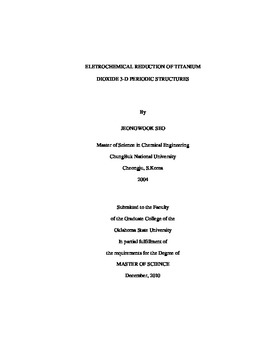| dc.contributor.advisor | Smay, Jim | |
| dc.contributor.author | Jeongwook, Seo | |
| dc.date.accessioned | 2014-04-16T03:07:24Z | |
| dc.date.available | 2014-04-16T03:07:24Z | |
| dc.date.issued | 2010-12-01 | |
| dc.identifier.uri | https://hdl.handle.net/11244/9638 | |
| dc.description.abstract | The conversion of rutile (TiO 2 ) to TiO is carried out using a molten-salt electrochemical process known as the FFC method, which was suggested by Fray et al. In previous research, a dry-pressed rutile pellet is partially sintered and then electrochemically converted to Ti sponge. The Ti sponge can be crushed and sintered to produce a Ti billet for future machining operations. The guiding hypothesis of this research is that if the rutile is fabricated into a specific shape, the TiO 2 may be electrochemically converted to Ti directly while maintaining the desired shape. A three dimensional structure of TiO 2 is fabricated by robocasting, a process for assembling complex, three-dimensional (3-D) structures by extruding and patterning colloidal gels (pastes) followed by drying and sintering of the particles. Here, a TiO 2 paste is developed and evaluated by viscosity measurement. A 3-D lattice structure is fabricated using the robocasting method and the lattice structure is used as the feedstock for a molten CaCl 2 electrochemical reduction process. The reduction process is carried out using two different conditions. The control condition (the FFC method) uses a constant 3.2 V cell potential and allows current to vary as limited by the sample size and chemical reactions. The test condition is to maintain a constant current by varying the cell potential from 3.2 V to 4.2 V during the course of the electrochemical reaction. The control condition produces the expected chemical changes observed by others using the FFC method. The test condition yields an abundance of TiO nanofibers on the surface of the 3-D lattice. For both conditions, the reaction is terminated prior to conversion to Ti metal and the intermediate products are analyzed. The test condition consumes the CaCl 2 electrolyte. The electrolyte consumption is problematic for the notion of scale-up of this process, but the research produced some interesting TiO fibers that may prove worth the unfavorable reaction conditions. For instance, TiO fibers have not been reported in the literature, but may have application as catalysis material. | |
| dc.format | application/pdf | |
| dc.language | en_US | |
| dc.publisher | Oklahoma State University | |
| dc.rights | Copyright is held by the author who has granted the Oklahoma State University Library the non-exclusive right to share this material in its institutional repository. Contact Digital Library Services at lib-dls@okstate.edu or 405-744-9161 for the permission policy on the use, reproduction or distribution of this material. | |
| dc.title | Eletrochemical Reduction of Titanium Dioxide 3-D Periodic Structures | |
| dc.type | text | |
| dc.contributor.committeeMember | Johannes, AJ | |
| dc.contributor.committeeMember | Ramsey, Josh | |
| osu.filename | Jeongwook_okstate_0664M_11273.pdf | |
| osu.college | Engineering, Architecture, and Technology | |
| osu.accesstype | Open Access | |
| dc.description.department | School of Chemical Engineering | |
| dc.type.genre | Thesis | |
| dc.subject.keywords | robocasting | |
| dc.subject.keywords | titanium dioxide | |
| dc.subject.keywords | titanium oxide fiber | |
